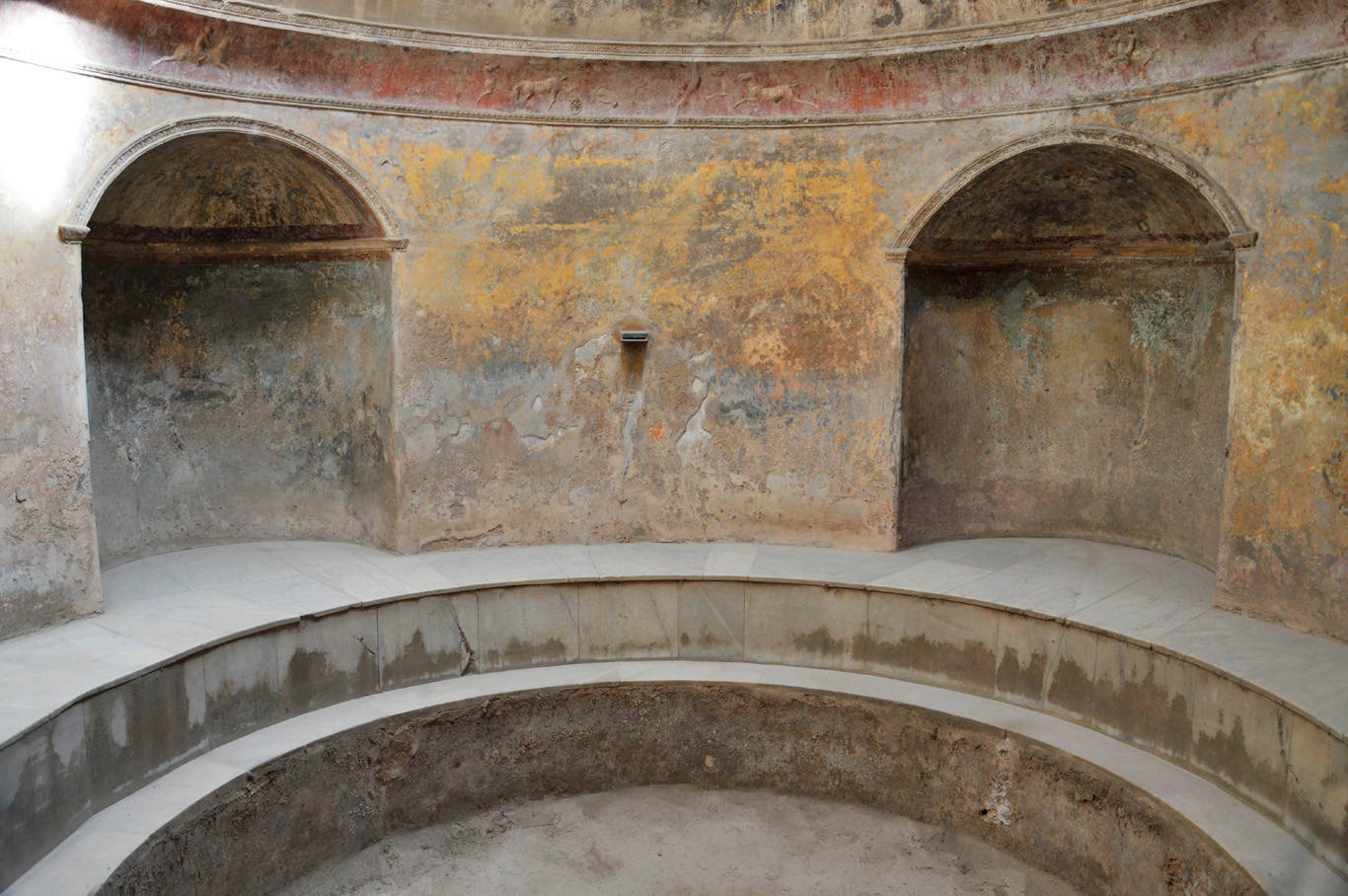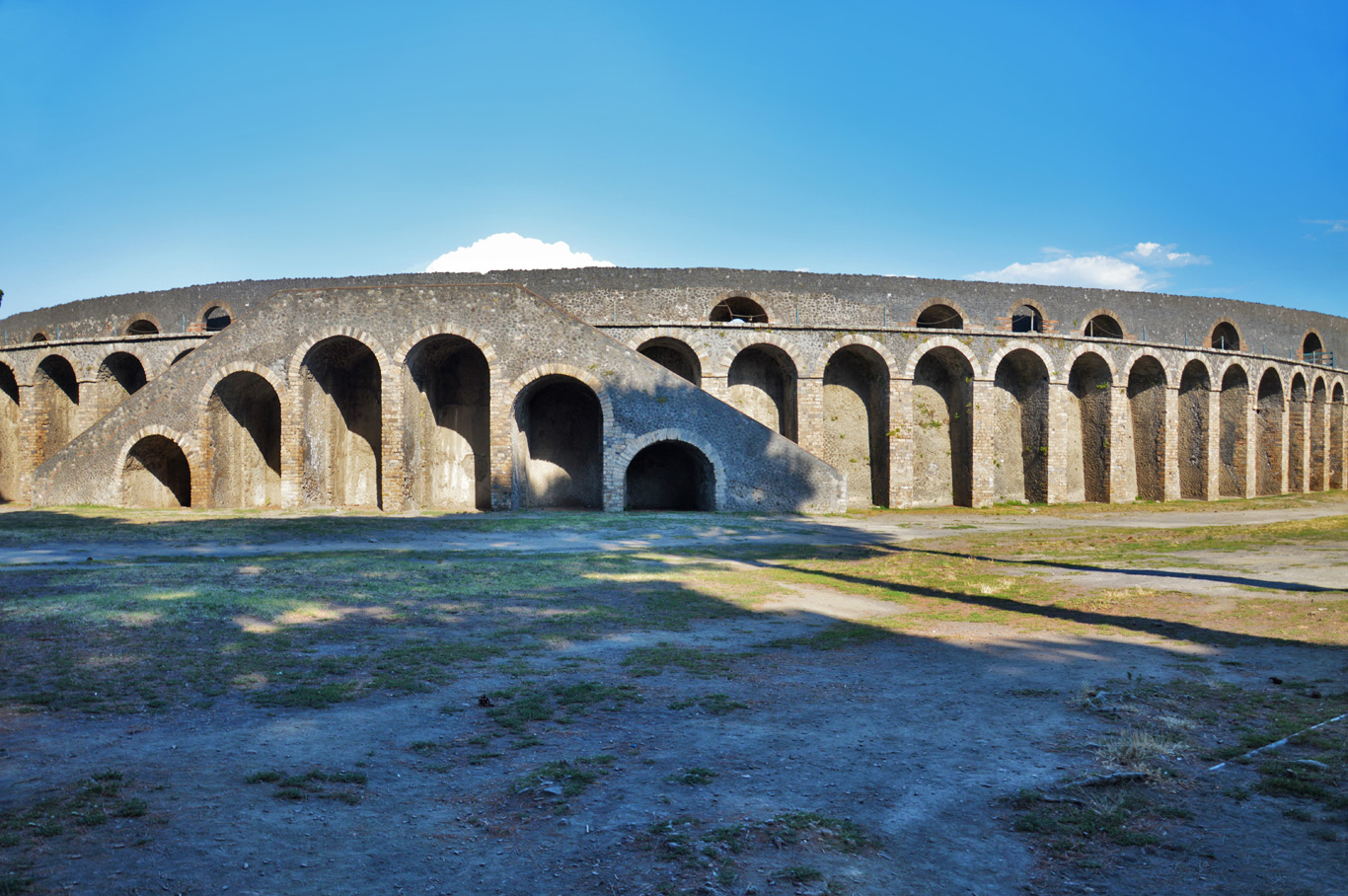Pompeii is one of the most famous archaeological sites in the world. It's been featured in numerous Hollywood productions and is a symbol of the sophisticated life in ancient Rome. The tragic fate following the eruption of Mt. Vesuvius in 79 AD made this beautiful seaside town cease to exist overnight. The ashes of the volcano sealed and protected the streets with houses of Pompeii from invaders and atmospheric conditions for centuries to come. Excaveted as late as in the 18th century, the perfectly well preserved statues, frescoes, shops and streets have revealed how advanced the ancient Romans were. Pompeii became a literal time capsule.
How to get to Pompeii
The closest city from Pompeii is Naples, but if you have a free couple of days, it's very easy and quick to visit the site also from Rome. There are many trains between Rome and Naples, they are not too expensive and the journey takes only around 2 hours 30 minutes.
From the main train station in Naples, you need to use the Circumvesuviana city trains. Make sure that you take the train which goes to Sorrento and get off at the station Pompeii Scavi. There is another station called just Pompeii - it is the modern town - don't get off there. It is located 2 stations after Pompeii Scavi, however, it's on a different line - Poggiomarino. So make sure your train destination is Sorrento, not Poggiomarino.
We made this mistake and took the train to Poggiomarino instead of Sorrento. We had to get off at the Torre Anunziata Oplonti station and wait for the next train which went to Sorrento. Have a look at the detailed map here.
Entry fee to the Pompeii is 11 EUR for an adult, but there are some discounts and also combined tickets that you can use to see other sites too. You can find all the details here.
Visiting Pompeii
Surprisingly, before I visited Pompeii, I thought it would be just a usual ancient site. But it's not! Pompeii is not like the Colosseum or Roman Forum in Rome where you can see a few terribly damaged columns still standing and a sea of tourists. Pompeii is an entire town with its streets, squares, shops and houses in a very good condition. Everything you see around is original, more than 2000 years old.
That's why you should allow at least one day to roam around along the narrow, long streets of Pompeii. It's quite big! At the entrance, you're going to get a map where you can find all the most important places marked. Be prepared for all day of walking.
The disaster - What happened in Pompeii
Pompeii had been a normal, Roman town - nothing special or extraordinary the way it is considered now. One day, on August 24 or October 24, the Mt. Vesuvius erupted, spewing lava and sweeping everything across its slopes all the way to the shores of the Mediterranean Sea. Seaside towns, like Pompeii and Herculaneum ceased to exist within 24 hours. The fate of Herculaneum was more drastic as the extremely hot gases and toxic fumes killed instantly those who had stayed in the town. Pompeii, in turn, was covered with surges of mud and bombarded with stones. In this state, it had remained buried for over 17 centuries before it was rediscovered in 1748.
The fact that the entire town was underground for such a long time saved it from invaders, thieves and other traumatic historical events. Nowadays, it provides and unparalleled insight into what life was like in ancient Rome.
Torre Anunziata station
Pompeii Scavi station
The main gate to Pompeii
The forum
The forum, the temple and statue of Apollo
The forum
One of the streets
A bakery
The baths
Marble washbasin in the baths
The baths
Statues in the baths
The baths
A street in Pompeii
The forum
The forum of Pompeii was the central plaza in the town. It's pretty damaged comparing to the other buildings, but still better preserved than other ancient sites. Here, you can admire ruins of temples (Temple of Apollo) and the statue of Apollo is still standing to this day. From here, you can also easily spot the peak of the formidable Mt. Vesuvius that had buried Pompeii.
The baths
The public baths of Pompeii are an absolute treasure of archaeology. They are the few of the city's buildings that are perfectly preserved - together with the ceiling, marble tubs and many carefully carved statues. The feeling of getting in the baths which were the social center of the ancient world is incomparable to anything. Any other boring museum can't compare to it - here, you can see all the things exactly through the eyes of the people who lived in Pompeii 2000 years ago.
The houses
What's great about Pompeii is the virtually unlimited access to any part of the town. You can enter private houses, see their bedrooms, living rooms and gardens. It's a very strange sensation, just as if you were about to enter the private lives of the long gone residents.
What's unique about Pompeii is that the color on the interior walls as well as decorations on the fountains are all original - just the way they were right before the disaster, twenty centuries ago.
The streets
The streets of Pompeii are narrow and have their own drainage system. You can still notice the trails carved by the horse carriages in the surface of the streets and huge stones used for pedestrians to step on them and cross to the other side.
Along many streets in Pompeii, you can still see the shops, bars and bakeries. The ovens are still there intact as if they were waiting for the people to bake bread in them. Note that original homes and walls were colorful from the outside too - you can still find some signs and beautifully decorated details on the outer side - however not as numerously present as those inside.
The amphitheater
The amphitheater in Pompeii is the oldest in the Roman Empire that survived until this day. It was used for gladiator fights as well as concerts, plays and other events.
The victims
You can still see the casts of those who perished during the eruption of Mt. Vesuvius. Their bodies had been covered and buried by ash and mud which hardened over the centuries. Later on, they decayed leaving an empty space in the ground. While excavating Pompeii, the scientists filled those gaps with plaster and the twisted, crawling shapes of the victims appeared.
Frescoes on the outside
Pompeii
House of the Small Fountain
House of Diomede
Beautiful frescoes in the House of the Faun
The ovens
Gardens in one of the houses
The house of the Faun
A street and stones used for crossing
House of Stephanus
House of Stephanus
The walls of the amphitheater
The casts of the victims
The casts of the victims
New Pompeii
New "resident" of Pompeii
Is Pompeii worth seeing?
Pompeii is a completely different experience to, let's say, visiting the Roman Forum in Rome. Although it's really touristic, the area is still so great in size that strolling along the ancient streets is really pleasant. Everything is really well preserved and you'll feel like you were teleported back in time. It's an amazing experience and definitely worth the cost! Especially, if you're interested in antiquity!
Visit also
The nearby town of Herculaneum is much less popular and in some places even better preserved than Pompeii! You can still see the original, colorful outside walls and sculptures - it turns out that Roman figures were not white, they were painted! In Herculaneum, what's really unbelievable, you can also see the original wooden staircase and logs supporting the ceiling of the second story - yes, even 2-story buildings were preserved whole!
You can also hike up Mt. Vesuvius - it's easy to do so, you have to get off at the Ercolano Scavi station - right where Herculaneum is located. There are minibuses departing every hour or so, then you can do the hike and catch a minivan back. You can combine this trip together with visiting Herculaneum.
Have a look at "Related Posts below to find more articles about Herculaneum and Italy.
If you liked this article, you can also download it via the GPSmyCity app - you will be able to gain access to the guide, which will direct you to all the attractions described above, even if you're offline. Download it here.
Related Posts
Copying without permission is not allowed. If you wish to use any of the site's content (photos or text) or work with us, please contact us.
We welcome questions, advice, support or criticism. However, spam comments will be removed.





































